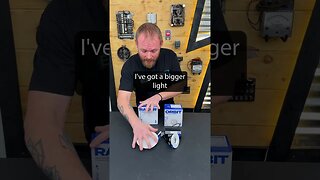Premium Only Content

Where Should We Be Using Dual Function Breakers?
Join this channel to get access to perks:
https://www.youtube.com/channel/UCB3jUEyCLRbCw7QED0vnXYg/join
When installing circuitry into a residence, it is important to refer to the NEC to determine exactly what types of protection are needed. GFCI protection and AFCI protection being among them. But what about dual function breakers? In the latest episode of Electrician U, Dustin brings to light what a dual function breaker is and where would be the places to install them.
🤘⚡️MEMBERSHIP⚡️🤘
JOIN ELECTRICIAN U - become a member and get:
FREE Continuing Education every year
FREE Practice Exams
FREE Monthly Video Courses
FREE Weekly Live Instructor-Led Classes
FREE Monthly Educational Newsletter
Premium Members-Only Content
Private Discord Channel
Monthly Members-Only Discord Chats
Sign up here --- https://www.electricianu.com/electrician-u-membership/
🎧🎹MUSIC AND VIDEO:🎹🎧
https://www.facebook.com/descantmv
🎬✍️ART AND ILLUSTRATION:✍️🎬
https://www.daverussoart.com
Let’s discuss the difference between the standard GFCI breaker, a standard AFCI breaker, Combination breakers, and Dual Function breakers so there isn’t confusion with terminology. A standard GFCI breaker senses the difference between what’s going OUT to the load and what’s coming BACK and interrupts the circuit if there is a big enough difference to cause damage to personnel. There are 2 kinds of standard AFCI breakers. A Series AFCI breaker will sense if there is a break in a single wire (where there would be an arc from one side of that wire to the next) and will interrupt the circuit. A parallel AFCI breaker senses a small amount of arcing between a neutral and a hot of the same circuit (not enough to be a dead short but smaller arcing) and interrupts the circuit. A combination breaker has the capability to protect from BOTH Series AND Parallel arcs. And lastly, a Dual Function breaker will protect against Ground Faults AND Arc Faults.
The installation of a GFCI breaker isn’t specifically lined out in the NEC, just that GFCI protection for certain devices is required. Remember, GFCI protection is generally limited to the device, whereas AFCI protection is required for the entire circuit. Considering both the need to keep cost down AND convenience for the end user, a single GFCI breaker could take the place of several GFCI receptacles within a circuit or negate the need to run a large distance to protect the next receptacle in line of the GFCI device protecting it. In other words, a GFCI breaker will protect ALL the receptacles on the circuit. An AFCI breaker will do exactly the same thing, just from an Arc Fault standpoint in lieu of a Ground Fault.
Article 210.8(A) of the NEC covers GFCI requirements in a residential installation while article 210.12(B) covers AFCI requirements of the NEC. If you were to look in the code, you would see that several of those areas are required to have BOTH GFCI and AFCI protection. Enter the Dual Function Breaker. Take a residential kitchen for example. You could put a dual function breaker in several of the circuits in the kitchen, thus negating the need for an AFCI breaker AND a GFCI device. A laundry room could be done the same way as the requirement is there for both forms of protection. It potentially could save the contractor/owner/GC money by combining several forms of the required protection into one device and will certainly save the homeowner/contractor some aggravation by trying to figure out what exactly has tripped. A single breaker would be the source of turning the offending circuit back on (after troubleshooting it to figure out WHY it tripped!).
Another reason to use a dual function breaker in lieu of both a breaker for AFCI protection and a GFCI device for protection is that the breakers tend to be a bit more robust and will fail less frequently than a device. Especially the WR GFCI breakers installed outside as they are constantly exposed to the elements. This, overtime, could amount to significant savings in replacement. As always, refer to the current version of the NEC to find the protection requirements for your situation as codes are reworked every 3 years. Also, it may be work answering customers questions as to why you would install a Dual Function breaker or individual devices. It certainly pays to help them understand why we install things the way we do.
We hope this has been helpful in understanding the specifics of Dual Function breakers. Is there a topic you would like to see discussed on Electrician U? Leave a comment in the comments section and let us know. Please continue to follow Dustin and Electrician U as we are constantly updating our content to assist our followers in becoming the best electricians that they can be.
-
 0:50
0:50
Electrician U
1 year agoWhat Are Lumens?
13.2K4 -
 12:54
12:54
MetatronGaming
2 hours agoYou Remember Super Mario WRONG and I can Prove it
1322 -
 1:02:55
1:02:55
Russell Brand
2 hours agoThe Epstein Files Are Coming — And The Establishment Is Terrified! - SF653
67.2K12 -
 32:47
32:47
The White House
2 hours agoPresident Trump Meets with Zohran Mamdani, Mayor-Elect, New York City
10.1K18 -
 1:07:21
1:07:21
The Quartering
1 hour agoPeace Between Ukraine & Russia? Kimmel Meltdown & More layoffs
15.8K5 -
 LIVE
LIVE
Barry Cunningham
2 hours agoBREAKING NEWS: PRESIDENT TRUMP MEETS WITH COMMIE MAMDANI | AND MORE NEWS!
2,143 watching -
 LIVE
LIVE
LadyDesireeMusic
1 hour agoLive Piano Music & Convo | Anti Brain Rot | Make Ladies Great Again | White Pill of the Day
104 watching -
 LIVE
LIVE
StoneMountain64
3 hours agoArc Raiders Making Money and LEVELING Up
85 watching -
 LIVE
LIVE
ReAnimateHer
5 hours agoNell’s Diner Is OPEN… For Your Final Meal
43 watching -
 14:53
14:53
Neil McCoy-Ward
9 hours ago🇦🇺 Australian Censorship Chief SUMMONED For Questioning In USA!!! 🇺🇸
2.64K5